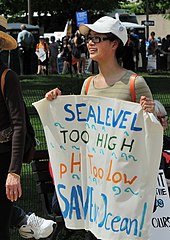Possible responses

Reducing CO
2 emissionsedit
Members of the InterAcademy Panel recommended that by 2050, global anthropogenic CO
2 emissions be reduced less than 50% of the 1990 level. The 2009 statement also called on world leaders to:
- Acknowledge that ocean acidification is a direct and real consequence of increasing atmospheric CO
2 concentrations, is already having an effect at current concentrations, and is likely to cause grave harm to important marine ecosystems as CO
2 concentrations reach 450 parts-per-million (ppm) and above;- ... Recognize that reducing the build up of CO
2 in the atmosphere is the only practicable solution to mitigating ocean acidification;- ... Reinvigorate action to reduce stressors, such as overfishing and pollution, on marine ecosystems to increase resilience to ocean acidification.
Stabilizing atmospheric CO
2 concentrations at 450 ppm would require near-term emissions reductions, with steeper reductions over time.
The German Advisory Council on Global Change stated:
In order to prevent disruption of the calcification of marine organisms and the resultant risk of fundamentally altering marine food webs, the following guard rail should be obeyed: the pH of near surface waters should not drop more than 0.2 units below the pre-industrial average value in any larger ocean region (nor in the global mean).
One policy target related to ocean acidity is the magnitude of future global warming. Parties to the United Nations Framework Convention on Climate Change (UNFCCC) adopted a target of limiting warming to below 2 °C, relative to the pre-industrial level. Meeting this target would require substantial reductions in anthropogenic CO
2 emissions.
Limiting global warming to below 2 °C would imply a reduction in surface ocean pH of 0.16 from pre-industrial levels. This would represent a substantial decline in surface ocean pH.
On 25 September 2015, USEPA denied a 30 June 2015, citizens petition that asked EPA to regulate CO
2 under TSCA in order to mitigate ocean acidification. In the denial, EPA said that risks from ocean acidification were being "more efficiently and effectively addressed" under domestic actions, e.g., under the Presidential Climate Action Plan, and that multiple avenues are being pursued to work with and in other nations to reduce emissions and deforestation and promote clean energy and energy efficiency.
On 28 March 2017 the US by executive order rescinded the Climate Action Plan. On 1 June 2017 it was announced the US would withdraw from the Paris accords, and on 12 June 2017 that the US would abstain from the G7 Climate Change Pledge, two major international efforts to reduce CO
2 emissions.
The prevention and significant reduction of all kinds of marine pollution including ocean acidification is part of the targets of the United Nations' Sustainable Development Goal 14.
Geoengineeringedit
Geoengineering has been proposed as a possible response to ocean acidification. The IAP (2009) statement said more research is needed to prove that this would be safe, affordable and worthwhile:
Mitigation approaches such as adding chemicals to counter the effects of acidification are likely to be expensive, only partly effective and only at a very local scale, and may pose additional unanticipated risks to the marine environment. There has been very little research on the feasibility and impacts of these approaches. Substantial research is needed before these techniques could be applied.
Reports by the WGBU (2006), the UK's Royal Society (2009), and the US National Research Council (2011) warned of the potential risks and difficulties associated with climate engineering.
Iron fertilizationedit
Iron fertilization of the ocean could stimulate photosynthesis in phytoplankton (see Iron hypothesis). The phytoplankton would convert the ocean's dissolved carbon dioxide into carbohydrate and oxygen gas, some of which would sink into the deeper ocean before oxidizing. More than a dozen open-sea experiments confirmed that adding iron to the ocean increases photosynthesis in phytoplankton by up to 30 times. While this approach has been proposed as a potential solution to the ocean acidification problem, mitigation of surface ocean acidification might increase acidification in the less-inhabited deep ocean.
A report by the UK's Royal Society (2009) reviewed the approach for effectiveness, affordability, timeliness and safety. The rating for affordability was "medium", or "not expected to be very cost-effective". For the other three criteria, the ratings ranged from "low" to "very low" (i.e., not good). For example, in regards to safety, the report found a "high potential for undesirable ecological side effects", and that ocean fertilization "may increase anoxic regions of ocean ('dead zones')".
Comments
Post a Comment